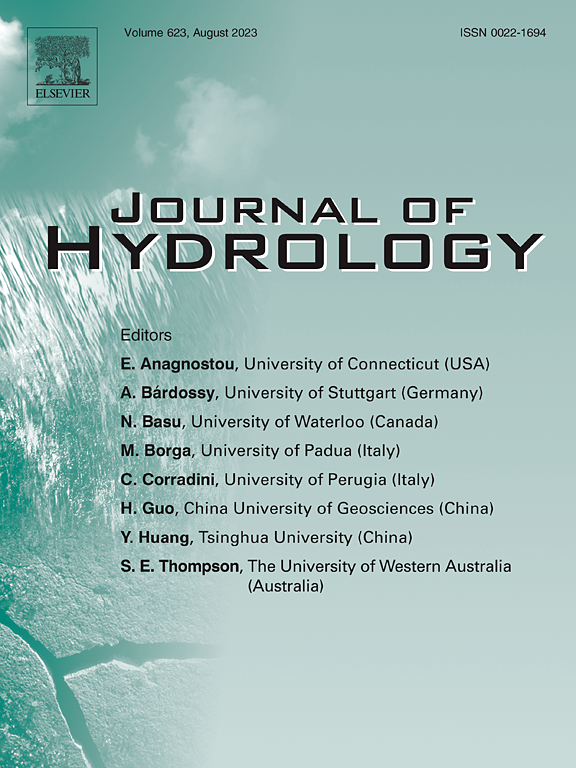Investigating sediment connectivity of a small catchment on the Loess Plateau using an appropriate index at an optimal spatial resolution
IF 5.9
1区 地球科学
Q1 ENGINEERING, CIVIL
引用次数: 0
Abstract
Sediment connectivity provides an effective geomorphological and hydrologic tool in understanding the impact of morphological complexity and anthropogenic modification on the spatial transfer of sediment fluxes within a geomorphic system. However, sediment connectivity studies presented numerous challenges in complicated topographic area, such as the hilly-gully loess region of Chinese Loess Plateau, primarily due to the limited knowledge on the appropriate resolution and weighting factor used for deriving connectivity. In this study, the sediment connectivity was evaluated at six airborne LiDAR-derived DEMs (between 0.25 and 5 m pixel sizes) to identify the optimum resolution. Then the performance of Index of Connectivity (IC) with different weighting factors was evaluated based on field connectivity index (FIC) and the response to the anthropogenic activities. Results showed that 1) the linear features and details of pathways and terrace could not be distinguished clearly with the pixel size above 0.75 m. The flow paths were misaligned in locations with rapidly changing topography when the pixel sizes larger than 0.75 m while these paths were extremely complex and inconsistent with field investigation at a resolution of 0.25 m. The 0.5 m pixel size was demonstrated as the proper spatial resolution for the IC calculation in the study catchment. 2) The relationships between FIC and five IC versions at 0.5 m resolution presented significant correlations (p < 0.01), with the revised index of sediment connectivity (RIC) presenting the strongest correlation (R2 = 0.51, p < 0.01). All the IC versions could reflect the effect of large-scale engineering disturbance (e.g., terrace, road) on sediment connectivity, whereas the connectivity index based on relative smoothness (ICRS) and RIC better characterize IC variations under small scale disturbance in complex terrain. 3) The sediment connectivity showed spatial heterogeneity in different times, with the high IC values mainly concentrated in the gully channels with runoff pathway and the gully slope with sparse vegetation and steep slope. This study provided scientific reference for sediment connectivity evaluation in topographically complex area.
黄土高原某小流域泥沙连通性的最佳空间分辨率指标研究
沉积物连通性为了解地貌系统中形态复杂性和人为改变对沉积物通量空间转移的影响提供了有效的地貌学和水文学工具。然而,在地形复杂的地区,如中国黄土高原丘陵沟壑区,沉积物连通性研究面临着许多挑战,主要原因是对用于推导连通性的适当分辨率和加权因子的了解有限。在这项研究中,沉积物连通性评估了六个机载lidar衍生的dem(在0.25至5 m像素之间),以确定最佳分辨率。然后以野外连通性指数(FIC)和对人为活动的响应为基础,对不同权重因子的连通性指数(IC)进行评价。结果表明:1)当像元尺寸大于0.75 m时,通道和阶地的线性特征和细节无法清晰区分;当像元尺寸大于0.75 m时,流道在地形快速变化的位置出现错位,而在0.25 m分辨率下,这些流道极其复杂,与现场调查结果不一致。0.5 m像素尺寸被证明是研究流域IC计算的合适空间分辨率。2)在0.5 m分辨率下,FIC与5个IC版本之间存在显著的相关性(p <;0.01),其中修正泥沙连通性指数(RIC)相关性最强(R2 = 0.51, p <;0.01)。所有IC版本都能反映大尺度工程扰动(如阶地、道路)对沉积物连通性的影响,而基于相对平滑度(ICRS)和RIC的连通性指数更能表征复杂地形小尺度扰动下的IC变化。③沉积物连通性在不同时期表现出空间异质性,高IC值主要集中在有径流通道的沟道和植被稀疏、坡度陡的沟道坡面。该研究为地形复杂地区沉积物连通性评价提供了科学依据。
本文章由计算机程序翻译,如有差异,请以英文原文为准。
求助全文
约1分钟内获得全文
求助全文
来源期刊

Journal of Hydrology
地学-地球科学综合
CiteScore
11.00
自引率
12.50%
发文量
1309
审稿时长
7.5 months
期刊介绍:
The Journal of Hydrology publishes original research papers and comprehensive reviews in all the subfields of the hydrological sciences including water based management and policy issues that impact on economics and society. These comprise, but are not limited to the physical, chemical, biogeochemical, stochastic and systems aspects of surface and groundwater hydrology, hydrometeorology and hydrogeology. Relevant topics incorporating the insights and methodologies of disciplines such as climatology, water resource systems, hydraulics, agrohydrology, geomorphology, soil science, instrumentation and remote sensing, civil and environmental engineering are included. Social science perspectives on hydrological problems such as resource and ecological economics, environmental sociology, psychology and behavioural science, management and policy analysis are also invited. Multi-and interdisciplinary analyses of hydrological problems are within scope. The science published in the Journal of Hydrology is relevant to catchment scales rather than exclusively to a local scale or site.
 求助内容:
求助内容: 应助结果提醒方式:
应助结果提醒方式:


